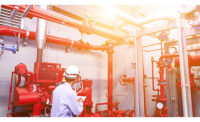Top considerations for manufacturing plant drainage systems

Safety and sanitation are leading concerns for manufacturing plants. Regular cleaning is crucial to ensuring both, and drainage systems are key to easier, more effective cleaning.
As straightforward as drains may seem at first, they come in many shapes and sizes. Consequently, manufacturers need to make sure they choose the right one for their needs.
Why manufacturing plants need drainage systems
In all their forms, drainage systems provide an outlet for excess water on the manufacturing floor. That could be to remove spills from the production equipment itself or to enable faster cleaning. Removing excess water and anything it contains is important for a few reasons.
First, manufacturers must keep floors dry to prevent slip hazards. Slips, trips and falls are the leading cause of nonfatal injuries and the third most common cause of preventable injury-related deaths. Without a way to drain water from the floor, these injuries are much more likely.
Secondly, drainage systems mean manufacturers can clean equipment faster. That means longer-lasting machines and fewer health risks from contaminant buildup. It can also help reduce pollution, and sustainable manufacturing is more cost-effective in the long run.
Types of drainage systems
The four most common types of drainage systems are floor sinks, trench drains, slot drains and area drains. The last category is most common in outdoor environments.
Floor sinks consist of small, covered basins and are the most compact of these systems. Trench drains take the same concept but stretch the basin over a longer area. Slot drains are also long but consist of a thin slot instead of a larger, grated opening. These are often uncovered.
Manufacturing drainage system considerations
Which of these solutions is best depends on a manufacturer’s specific situation. Here are five key considerations to review to determine the ideal manufacturing drainage system.
Regulatory requirements
The first and most important consideration is to go over any applicable laws or regulations. Some industries have specific environmental or sanitation requirements that could result in fines if manufacturers don’t abide by them.
Floor drains, for example, must be at least 3 inches in diameter in some areas. Where these pipes lead and what they can be made of may also have regulatory restrictions. In cases where manufacturers don’t fall under any specific codes, they should abide by the regulations closest to their situation to avoid any complications.
Type of contaminants
Manufacturers also need to consider the kinds of contaminants they’ll wash away. French drain-style systems contain four filtering layers to remove a lot of solid waste, which is ideal for food manufacturers or outdoor equipment. Facilities dealing mostly in liquid waste can get away with fewer filters or wider grates.
Some facilities may deal with harsh chemicals. In these cases, manufacturers must ensure the metals and plastics in their drainage systems can withstand potential corrosion hazards.
Sanitation needs
The facility’s cleaning needs are a similar drainage system consideration. Some cleaning chemicals may damage certain materials over time, so manufacturers should pay close attention to these risks.
Different materials also have varying sanitation qualities. Stainless steel is easy to clean but doesn’t have any antibacterial properties without additional treatment. It’s also important to consider how a drain’s design can impact cleaning. Slot systems drain slower than larger trench drains, which could lead to more downtime with thicker cleaning agents.
Water flow
Water flow rates are another key consideration for manufacturing plant drainage systems. Pipe diameters, drain sizes and grate types can all affect water flow, so manufacturers must know how much they need. Generally speaking, the more contaminants or water a facility sees at any given time, the higher the water flow rate its drainage system needs.
Slot drains typically have a lower flow rate, but deeper slots can make up for that. Trench drains enable the most water flow, but facilities with no solid contaminants and more water-efficient cleaning may not need that much.
Floor space
Finally, manufacturers need to consider their available floor space. Trench drains take up the most space, so facilities with less room may need to go for another option. In contrast, slot drains have been gaining popularity as they take up minimal room.
Space considerations tie in closely with installation time and difficulty. It’ll take longer and incur more expenses to install a larger drainage system, so manufacturers must review their budgets and efficiency benchmarks to determine how much they can afford.
Manufacturing drains require close attention
Drainage systems are easy to overlook, but they’re a crucial part of any manufacturing plant. They’re also easy to get wrong, considering how many factors influence ideal designs and selection. Consequently, manufacturers must take drainage system design and implementation seriously.
These five drainage considerations are not the only influencing factors, but they are the most significant. Keeping these in mind will help manufacturers select the safest, cleanest and most cost-effective drainage system for their needs.
Looking for a reprint of this article?
From high-res PDFs to custom plaques, order your copy today!





